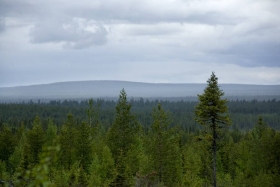Birnam Wood in the 21st Century: northern forest invading Arctic tundra as world warms

In Shakespeare's play Macbeth the forest of Birnam Wood fulfills a seemingly impossible prophecy by moving to surround the murderous king (the marching trees are helped, of course, by an army of axe-wielding camouflaged Scots). The Arctic tundra may soon feel much like the doomed Macbeth with an army of trees (and invading species) closing in. In a recent study, researchers found that climate change is likely to push the northern forests of the boreal into the Arctic tundra—a trend that is already being confirmed in Alaska.
Analyzing 16 global climate models starting in 1950 and ending at the close of the 21st Century, researchers found that the tundra of North America, Europe and Asia will be increasingly encroached upon by pine and deciduous forest.
"The response of vegetation usually lags changes in climate. The plants don't have legs, so it takes time for plant seed dispersal, germination and establishment of seedlings," Song Feng, research assistant professor at University of Nebraska-Lincoln's School of Natural Resource, said in a press release.
As temperatures rise regionally by 5.6 to 9.5 degrees Fahrenheit, a quarter to a half of the Arctic could be impacted, according to the study in Climate Dynamics, depending on future greenhouse gas emissions. Tundra vegetation is expected to lessen by 33-44% by 2099.
The ecosystem changes could impact climate as well, eplains Feng: "the expansion of forest may amplify global warming, because the newly forested areas can reduce the surface reflectivity, thereby further warming the Arctic. The shrinkage of tundra and expansion of forest may also impact the habitat for wildlife and local residents."
The models predicted
that the tundra would vanish quickest in North America with boreal
forest covering most of northern Canada and Alaska's tundra by
mid-century.
Happening in real time in Alaska
While Feng's study employed computer models to predict the future, a
recent study in Ecology Letter has shown that ecosystems are
already shifting in Alaska.
Combining satellite images and tree-ring data, the study found increased
growth of boreal forest at the edge of Alaska's tundra.
"The results provide evidence for the initiation of a biome shift in
response to climate change, and indicate that some ecosystem models may
be missing fundamental changes taking place in the circumpolar region,"
explained lead author Pieter Beck, a post-doctoral fellow at Wood's Hole
Research in a press release.
In addition, the study found that tree growth had actually slowed
throughout much of Alaska's forest.
"Recent temperature increases have reduced tree growth over most of
central Alaska, and increased growth in places where the temperature
used to be too low for optimum growth, such as the Western Alaska tundra
margin. Summer temperatures in central Interior Alaska are now almost
too warm for white spruce to survive," explained co-author Glenn Juday,
professor of forest ecology at the University of Alaska Fairbanks.
CITATIONS: Feng S., C-H. Ho, Q. Hu, R. J. Oglesby and S-J. Jeong
(2010).Evaluating observed and projected future climate changes for the
Arctic using the Koppen-Trewartha climate classification. Climate
Dynamics. DOI: 10.1007/s00382-011-1020-6.
Pieter S. A. Beck, Glenn P. Juday, Claire Alix, Valerie A. Barber,
Stephen E. Winslow, Emily E. Sousa, Patricia Heiser, James D. Herriges,
Scott J. Goetz. Changes in forest productivity across Alaska consistent
with biome shift. Ecology Letters, 2011; DOI:
10.1111/j.1461-0248.2011.01598.x
Copyright
mongabay
2010